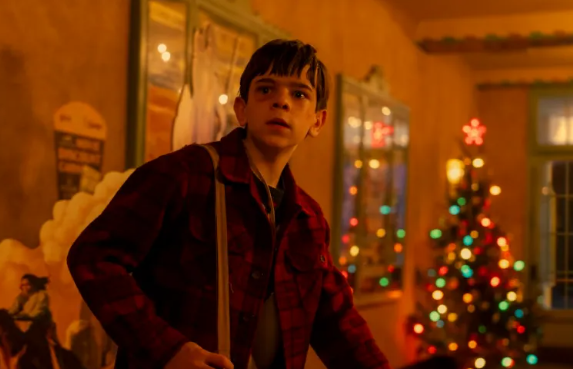The Story of IT: Welcome to Derry
The series IT: Welcome to Derry was developed by Andy Muschietti, Barbara Muschietti, and Jason Fuchs, and is based on Stephen King’s novel It. The show serves as a prequel to the 2017 and 2019 films (It and It: Chapter Two).
Set in 1962, in the fictional town of Derry, Maine, the series introduces new actors for the younger characters and marks the return of Bill Skarsgård as Pennywise the Clown. So far, it has received about 77% critical approval.

In this prequel, we delve into Derry’s past, long before the events depicted in the films. In 1962, when a new family moves to town, children start disappearing again, strange phenomena unfold, and several manifestations of the evil inhabiting Derry begin to surface, setting the stage for Pennywise’s return.
The goal isn’t just to explore the “monster,” but also the setting itself: the small town, the 1960s suburban life, and social tensions such as racism and collective fear. We see adults hiding secrets, children becoming victims or witnesses, and evil emerging both metaphorically and physically, turning the town into a character of its own.

The Town of Derry
Since the original novel It, Derry has never been merely the backdrop of the horror. It is the horror. The monster may appear as a clown or as fear itself, but Pennywise’s real power lies in his invisible influence: the corruption of the collective mind.
In Derry, evil doesn’t manifest only when it devours victims. It sleeps within people, changes their behavior, and numbs their empathy. Adults walk the streets without noticing missing children. Neighbors stay silent. Police ignore evidence.
The town learns, like a living being, to overlook suffering. That’s the most terrifying part, because horror becomes absorbed into normalcy.

Stephen King has always hinted that Pennywise doesn’t just live in the sewers. He emits a psychic influence that shapes Derry through the decades. His presence acts like an infection that turns fear into routine. When the clown awakens, he comes to life, but the town falls into a deep, apathetic sleep.
That’s where Welcome to Derry seems to find its greatest strength. By going back to the 1960s, the story can show how this moral numbness began. What makes an entire community pretend nothing is happening? Why do Derry’s adults seem complicit, even unconsciously?
The series may reveal that Pennywise’s power goes beyond physical appearances. It is the power to drain people of their humanity. The town breathes his influence and his fears. Each generation grows more accustomed to the strange and more detached from innocence.

In other words, Derry is Pennywise. The creature doesn’t rule over the town; it is the town. Its sewers are veins, and its citizens are cells.
This symbolic fusion of place, monster, and memory may be what Welcome to Derry succeeds in exploring.
Series and Films
The 2017 and 2019 films focused on two distinct timelines: the childhood of the Losers’ Club and their adulthood, highlighting themes of friendship, trauma, and overcoming fear.
The new series takes a different approach by traveling back in time to expand the universe. It doesn’t just offer “more Pennywise,” but asks how and why Pennywise exists in Derry and why Derry attracts evil in the first place.

If done well, this opens up possibilities. The series can explore deeper mythology and incorporate historical and social themes that the films only hinted at.
However, it also faces challenges. Compared to the films, the series could risk dragging, meandering, or relying too much on fanservice to connect dots. For fans of the movies, this shift from “childhood friendship and jump scares” to “slow-burn origin and social horror” might make the chemistry between characters or the emotional impact feel different.

About the First Episode of IT: Welcome to Derry
The atmosphere and setting work perfectly together. In the first episode, Derry feels less polished and more sinister, which helps emphasize its dual nature. From the opening scenes, you can feel the character’s dread about entering Derry. The direction does a great job of pulling the viewer into the story.
At several points, the episode doesn’t shy away from disturbing imagery. The visceral horror is there in the details. The car birth scene and the massacre in the movie theater stand out, with the latter especially subverting expectations. A strong start.

The social themes also introduce another kind of horror—racism, militarization, and marginalization. These elements give the story more depth than a simple “monster that can be defeated.”
For Stephen King fans, the expanded mythology is a real treat.

Is Welcome to Derry Worth Watching?
I really enjoyed the first episode, especially the unexpected take on the group of children. Despite their short screen time, each character feels distinct and memorable. It went beyond my expectations, offering something fresh rather than repeating the familiar Stranger Things or classic It formula.

However, I’m still unsure how the military subplot will play into the story and how it will affect the mythology of a town where adults are numbed by Pennywise’s presence. I’m curious to see how the next episodes unfold and hope Derry delivers a pleasant surprise.
Because a terrible surprise in that town would definitely not end well, would it?
After visiting Derry, do you still think the real monster is Pennywise, or is it the adults who ignore what’s rotting right in front of them? Share your thoughts in the comments!














— commentaires 0
, Réactions 1
Soyez le premier à commenter